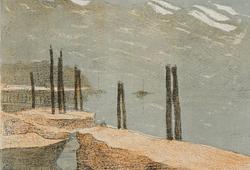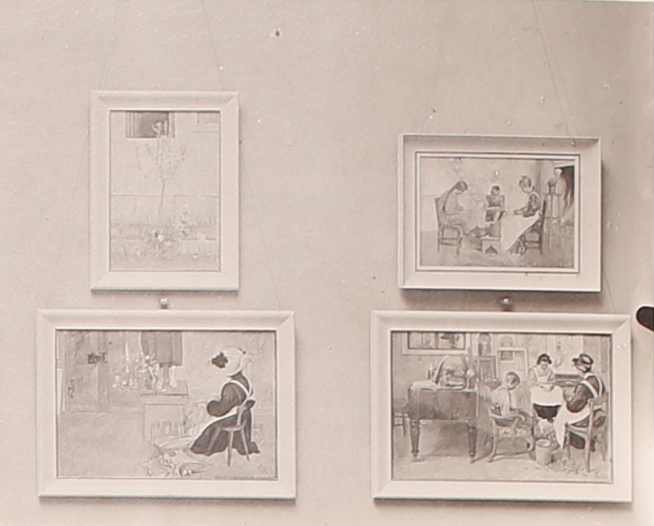Carl Larsson
"Dom spritar ärter"/ "Ärtspritning"
Signed C.L. within a circle and dated 1908. Watercolor 53 x 75 cm.
Import VAT
Import VAT (12%) will be charged on the hammer price on this lot. For further details please contact customer service +46 8-614 08 00.
Provenance
Gift to Editor Richard Gustafsson from the artist 1913.
Mrs. Thérèse Gustafsson.
Mrs. Ebba von Lesser, born Gustafsson.
Private Collection.
Exhibitions
Travelling exhibition "Åt solsidan", 1909-1914.
"Invigningsutställning - Larsson-Liljefors-Zorn", March - April, 1916, cat. no. 82. (under the title "Ärtspritning", then belonging to editor Rich. Gustafsson).
Liljevalchs konsthall, Stockholm "Minnesutställning - Carl Larsson", March 6 - April 5, 1920, cat. no. 232. (under the title "Ärtspritning", then belonging to Fru Thérèse Gustafsson).
Liljevalchs konsthall, Stockholm, " Carl Larsson- Bruno Liljefors- Anders Zorn", July 9 - August 17, 1930, cat. no. 51. (under the title "Ärtspritning", then belonging to Fru Ebba von Lesser, born Gustafsson).
Blaafarvevaerket i Modum, Norway, "Hipp-hipp-hurra! 30 år med skandinavisk kunst på Blaafarvevaerket ", May 19 - September 23, 2007, cat. no. 31, illustrated full page in colour p. 45.
Lillehammer Kunstmuseum, Norway, "Å hjemme seg. I Sigrid Undsets hus er det mange rom", May 20 - October 27, 2019.
Literature
"Carl Larsson, signerad med penna och pensel", 1999. Listed in the catalogue under 1908, cat. no 1265, illustrated in colour p. 413.
Ulwa Neergaard, "Carl Larsson. Signerat med pensel och penna", 1999, illustrated in colour p. 413 and listed in the catalogue under year 1908, no 1265.
Lena Rydin, "Den lustfyllda vardagen - Hos Larssons i Sundborn", 1992, illustrated in colour p. 136.
More information
On December 26, 1913, Richard Gustafsson wrote to his friend Carl Larsson to express his gratitude for a Christmas gift. In the letter, he described how he and his family had celebrated Christmas Eve at their eldest son's home and returned home late, only to be surprised by the presence of "a friendly Santa Claus who had been up on the hill and left a Christmas gift." The gift was the painting "Dom spritar ärter/ Ärtspritning," created by Carl Larsson in 1908. He also wrote:
"I have had a couple of paintings from your hand before… from your youth… and they have always been dear to me, but the painting you have now gifted me with will certainly double my joy in old age, for it is the epitome of the genre with which you have etched yourself into the heart of the Swedish people. As long as my eyes can see, I will rejoice in your bright image from the Larsson dynasty[...]."
As Gustafsson described, the painting depicts the artist's family in the studio at Lilla Hyttnäs in Sundborn. In the painting, you can see his wife, Karin, together with their two youngest children, Kersti and Esbjörn, deeply engrossed in shelling peas. In a comment on bringing household chores into the studio, the artist wrote: "Yes, even this they do, Karin, Brita, and Esbjörn, in my private studio! I am a pushover!"
Behind the family, you can catch a glimpse of a large-scale sketch for Larsson's ceiling mural, "Dramats skapelse" (The Creation of Drama), intended for the The Royal Theater's grand marble foyer. It is propped against the wall behind the ladder that Carl Larsson likely used to reach the expansive surface with his chalk.
In "Dom spritar ärter/ Ärtspritning," the sun streams into the studio, filling the room with light, which is a theme related to Carl Larsson's book "Åt solsidan" from 1910, where this painting is included. He explains the book's title in the opening paragraph: "Åt solsidan. That's what the book will be called this time. We do have windows on all sides, but, of course, the name is symbolic. We want to have sun in our lives just as we want to have it in our rooms."
Behind Karin, the artist has painted a cactus on a tall flower stalk from which a flower has bloomed. Flowers and plants were important elements in Carl Larsson's artistic work. He wrote in "Åt solsidan" ("Towards the Sun"): "Most often, it's a flower that first captures me, and I cannot find peace in my soul until I have painted it [...]." Karin's dress also provides an opportunity for Carl Larsson to study and capture the delicately decorative qualities of nature. The blue dress with white floral details recurs in the painting "Brudtärnan" (The Bridesmaid), also created in 1908 and included in "Åt solsidan." Together with the sketch for the The Royal Theater's ceiling in the background, the dress creates a contrast to the sharp lines of the furniture, forming a composition filled with dynamism.
Artist
Carl Larsson is considered one of the greatest Swedish artists of all time. He was born in Gamla Stan in Stockholm and studied at the Royal Academy of Arts in the years 1866-76. After his studies in Stockholm, he traveled to France and settled in Grèz-sur-Loing. There he mainly painted garden motifs. In France, he met his future wife Karin Bergöö, who was also an artist and came to mean a lot for his artistry. Already during his student years, he made a living as a photo retoucher and cartoonist in the press. It was also during his studies that Larsson got to know Anders Zorn and Bruno Liljefors, together the three are usually called the ABC artists. At the end of the 1880s, Carl and Karin were given "Lilla Hyttnäs" in Sundborn outside Falun by Karin's father, and this is where Larsson's most famous watercolors depicting his family were created. The motifs often depict sunny landscapes with children, crayfish fishing, meals in the green and interior scenes. Larsson is represented, among other, in the National Museum, where "Gustav Vasas intåg i Stockholm" and "Midvinterblot" fills the stairwell. Represented mainly at the National Museum in Stockholm and at the Gothenburg Art Museum.
Read more

































































